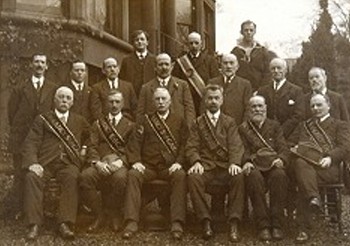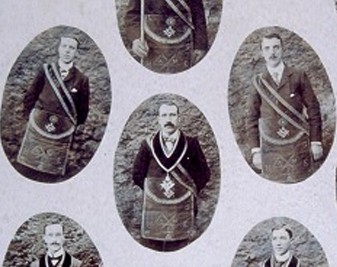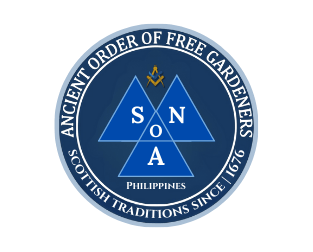The Roots and History of the Ancient Order of Free Gardeners
In medieval times, skilled trades like masonry and baking formed "incorporations" – formalized groups with significant standing in their local communities, often with contracts with town councils. Gardeners, however, faced a unique challenge
RW Ryan Ramos
7/16/20256 min read


Introduction to the Ancient Order of Free Gardeners
The Ancient Order of Free Gardeners is a fraternal organization with deep historical roots in agriculture and horticulture. Established in the 18th century, it was founded to promote collaboration among individuals who shared a passion for gardening and the cultivation of the land. The order emphasizes a strong sense of fraternity and brotherhood, aiming to foster mutual support among its members while engaging in community service. Through various initiatives, the Ancient Order of Free Gardeners inspires individuals to contribute positively to their local environments.
One of the core principles of this organization is the celebration of shared values that connect individuals through their love of gardening. Members are encouraged to share knowledge and experience, thereby enhancing their skills and fostering a greater appreciation for the horticultural arts. This emphasis on experiential learning serves to elevate not only individual gardening practices but also the community as a whole, as members band together to create more vibrant and sustainable gardens.
Moreover, the Ancient Order places a particular focus on the significance of community service. By organizing workshops, educational programs, and local events, the order actively works to improve public awareness about the benefits of gardening and sustainable agricultural practices. The ideals of the Ancient Order of Free Gardeners extend beyond mere plants; they encompass a commitment to enhancing the quality of life within and among communities. This connection between gardening and social responsibility is central to the identity of the organization and remains relevant even today.
As we delve deeper into the rich tapestry of the Ancient Order of Free Gardeners, we find that its historical significance and ongoing contributions to gardening and community development illustrate why this organization continues to thrive and inspire individuals globally.
Historical Background and Development
The Ancient Order of Free Gardeners originated in the 18th century amidst significant socio-economic transformations in Europe, particularly in Scotland. This period was characterized by the Enlightenment, which brought about a heightened appreciation for knowledge, self-improvement, and community engagement. The emergence of the order can be linked to the agricultural revolution and the growing significance of horticulture and gardening as both a practical pursuit and a cultural pastime. The order was established as a fraternal organization, primarily aimed at providing mutual support among its members, who were often involved in the gardening and agricultural trades.
One of the key figures in the formation of the Ancient Order of Free Gardeners was William Forsyth, a notable botanist and gardener, who played a crucial role in promoting gardening practices and education during this time. The order began to formalize its structure and values, emphasizing the principles of community collaboration and self-governance. By fostering these ideals, the Free Gardeners sought to empower individuals through shared wisdom and collective efforts to advance horticultural knowledge. This socio-economic landscape fostered an environment where skilled workers could connect, share insights, and develop a sense of identity based on their common interest in gardening.
Symbolism and Insignia: The Craft of the Free Gardeners
The Ancient Order of Free Gardeners is characterized by a rich tapestry of symbolism and insignia, which plays a crucial role in conveying the values and philosophies of the organization. Central to this emblematic system are the square and compasses, which symbolize moral and ethical principles. These tools, traditionally associated with freemasonry and craftsmanship, reflect the order's emphasis on virtue, integrity, and the importance of cultivating not only the earth but also one’s character.
The square, often seen as a metaphor for proper conduct and behavior, encourages members to act justly in their dealings with others. The compasses, on the other hand, represent the boundaries of personal ethics and the need for self-regulation. Together, they create a harmonious balance that embodies the ideals upheld by the Free Gardeners, focusing on the significance of fraternity and mutual support among members. This ethos is crucial in fostering a cooperative spirit within the order, as gardening itself often requires collaboration and shared knowledge among community members.
The insignia of the Free Gardeners manifests in various forms, with notable examples found in places like Melbourne, Australia. Here, the symbols are often integrated into local architecture and community gardens, illustrating how the order continues to influence agricultural practices and communal relationships. For instance, the inclusion of the square and compasses in the insignia serves as a reminder of the commitment to ethical gardening and the importance of environmental stewardship. This connection between practice and philosophy highlights how symbolic representation is vital for the identity of the Ancient Order, further forging bonds between members and their shared goals.
The Modern-Day Free Gardeners: Legacy and Influence
The Ancient Order of Free Gardeners, though rooted in history, has managed to maintain its relevance in contemporary society. As urbanization and industrialization have transformed landscapes, the principles of the Free Gardeners continue to resonate. This organization emphasizes sustainable gardening practices, community involvement, and the preservation of traditional horticultural knowledge, making it a vital force in today’s ecological discussions.
One of the significant adaptations of the Free Gardeners is their emphasis on modern values such as inclusivity and environmental stewardship. While the original order focused on the needs of its members, contemporary branches have expanded their mission to promote community gardening. This endeavor not only helps beautify local neighborhoods but also encourages sustainable lifestyles. The Free Gardeners actively engage in educational programs, workshops, and volunteering initiatives, aiming to foster a sense of community while safeguarding ecological health.
However, the order does face challenges in the modern era. The growing disconnection between urban populations and nature presents a barrier to the promotion of gardening traditions. Furthermore, as interest wanes in some regions, sustaining membership and participation has become increasingly difficult. To combat these issues, the Free Gardeners have embraced digital platforms, utilizing social media and online content to reach a broader audience. This initiative serves to attract new members and create partnerships aimed at enhancing local gardening efforts.
Moreover, the contributions of the Free Gardeners extend beyond individual gardens. Initiatives focused on educational outreach have played a crucial role in enhancing public awareness about environmental issues, such as biodiversity loss and climate change. For individuals interested in joining the movement, numerous local chapters invite new members to discover and contribute to this rich legacy. Engaging with the Free Gardeners can inspire deeper connections with nature while embracing the core values of sustainability and community empowerment.
The Roots of Regulation: Gardeners Organize for Reputation
In medieval times, skilled trades like masonry and baking formed "incorporations" – formalized groups with significant standing in their local communities, often with contracts with town councils. Gardeners, however, faced a unique challenge. Many lived outside of established towns on landed estates or in market gardens, making it difficult for them to gain the coveted incorporation status. Despite this hurdle, they felt a strong need to regulate their skills and training, driven by a desire to protect their professional reputations.
To overcome their geographical isolation and lack of formal incorporation, gardeners organized themselves into Lodges. These Lodges established clear guidelines for their craft, including membership qualifications and organizational structures, effectively regulating the industry from within. While the Incorporation of Gardeners of Glasgow is believed to be the sole group in Scotland to achieve official incorporation status by 1626 (encompassing both gardeners and greengrocers), no other gardeners' incorporation emerged elsewhere. By the 17th and 18th centuries, the creation of new incorporations had largely ceased.
Expansion and the Rise of Friendly Societies
Some of these individual Lodges eventually banded together to form "Orders" led by a "Grand Lodge." Several such Orders existed in Edinburgh, Glasgow, and England, though many older Lodges maintained their independence, leading to a lack of a single, overarching governing body. Attempts to create a unified Grand Lodge across Scotland were largely unsuccessful, with at least six different Grand Lodges operating concurrently.
The influence of the Free Gardeners extended beyond Britain's borders. The Order expanded to South Africa and Australia, and notably, three Lodges were established in the United States: Ash Lodge in New Jersey, America's First Thistle Lodge in New York, and Lonaconing Thistle Lodge in Maryland.
By the late 1800s, the Free Gardeners Lodges had largely shed their ties to the "Operative system" – their original trade-based focus – and evolved into "Friendly Societies." This shift allowed them to attract members from all walks of life, not just gardeners. This evolution was, in part, likely driven by their historical inability to gain widespread incorporation status, pushing them towards a model centered on mutual aid. By the 19th century, the primary function of most Lodges was to provide benefit services to their members. The Dunfermline Lodge even went a step further, forming a separate section dedicated to horticulture for those still interested in gardening as a craft.
Lodge Leadership: A Democratic Approach
The organizational structure of Free Gardeners Lodges was largely democratic, echoing the principles of Freemasonry. Officers were regularly elected, and the "box" containing their funds and important documents was subject to regular audits, ensuring transparency and accountability.
While titles varied by location – for instance, the senior officer in Dunfermline was initially called "Deacon" (later "Chancellor"), while Haddington used "President" or "Chairman" – common officer roles within the Lodges typically included the Master, two Wardens, a Chaplain, and Inside and Outside Tylers. These officers, often adorned with symbolic insignia, oversaw the day-to-day operations and welfare of the Lodge and its members.
The Free Gardeners' journey from a specialized trade group to a widespread network of Friendly Societies showcases the ingenuity and adaptability of communities seeking mutual support and protection, a testament to the enduring power of fraternal organization.


About IAOFG
Independent Ancient Order of Free Gardeners: a fraternal society rooted in Scottish gardening traditions since 1676
CONTACT - Whatsapp
Community
+1780-808-1392 | Alberta Canada
Independent Ancient Order Free Gardeners © 2025. All rights reserved.
+1206-659-1408 | Seattle, Washington
+63968-853-1346 | Philippines
+85265404907 | Kowloon, Hong Kong


EMAIL US:
Past Sovereign Master
Members Directory
Adult Leadership
